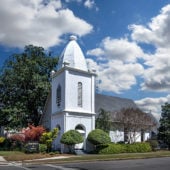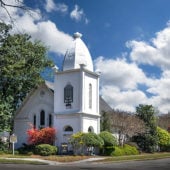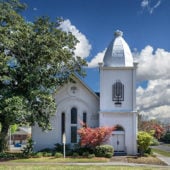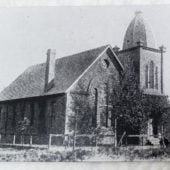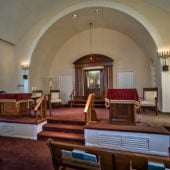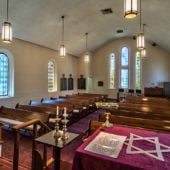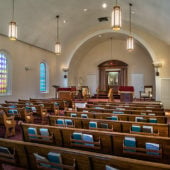The oldest building continuously used for Jewish worship in Alabama.
According to the Alabama Historical Society sign outside of the Temple, “Temple Beth El is the oldest building continuously used for Jewish worship in Alabama. Anniston’s Reform Jewish congregation was established in 1888. Its women’s organization, the Ladies Hebrew Benevolent Society, directed the construction of the building in 1893. They raised the money, purchased the lot, organized the building committee of men in the congregation, and named the house of worship Beth El or House of God. Sales of handiwork enabled the women to purchase stained glass windows. A trio of arched windows, emphasized by decorative brickwork and the domed tower, suggest the influence of ancient Byzantine architecture on the temple, which was listed in the National Register of Historic Places in 1985.
Architect George Parker described Temple Beth El in “Architectural Highlights of Anniston (1974): “The small but handsomely proportioned single story building has a rather Byzantine design inspiration; and the arched transom doorways, accenting arched windows, and arched relief of the façade create an exquisitely scaled composition well related to the narrow corner lot.”
The Founding of Temple Beth El
By Sherry Blanton
Anniston, Alabama’s permanent Jewish community got its start when Leon Ullman, a merchant doing business in Talladega, Alabama, a town about thirty miles from Anniston, chose Anniston as the location of his new enterprise. In 1884 with brothers Leopold, August, Abe, and Solomon in 1884 he opened Ullman Brothers on Noble Street, the main street of the city. There the business offered “a line of general merchandise.” The brothers were just the start of a migration of German Jewish business men who saw Anniston as a community of opportunity. Anniston, founded in 1872, had in 1883 changed from a private company town to an open one as the railroad reached the city. Anniston had grown up around an iron ore furnace and the homes of the furnace workers. Growth in the early public town was tremendous; as word of growing prosperity became known, other Jewish merchants joined the Ullman brothers; Joseph Saks, Adolph Adler, and Anselm Sterne soon operated thriving businesses. As in most other settlements, when enough Jews have settled in an area, they established a formal religious community, including a congregation, a place to bury their dead, and a religious school for the children. By the late 1880s there were enough Jews in Anniston to form a congregation; thus on April 1, 1888 Anniston’s Jews founded a congregation with the following purpose: “The worship of G-d in accordance with the usages and customs of our ancient religion; the preservation and perpetuation of the tenets and principles of Judaism, the fostering of communal life and the cementing of the bonds of religious fellowship.”
The early Jews had no permanent house of worship; they met in each other’s homes and in private halls, such as the Knights of Pythias Hall. Henrietta Sterne, the wife of Anselm Sterne, organized the first religious school in Anniston in 1889; in Albany, Georgia, where the couple and their children lived prior to their move to Anniston, she ran the religious school for that town’s Jewish children. Anselm and Henrietta Sterne, influential members of the congregation, invited Anniston’s Jewish women to their home and, with an inspiring speech, convinced the women of the need for a local charitable organization. On December 10, 1890 approximately fourteen women signed a document establishing The Ladies Hebrew Benevolent Society. Henrietta Sterne was the group’s first president, keeping that office until her death in 1915.
Although the women declared in their mission statement that they had come together for the purpose of “visiting the sick, aiding the poor, and promoting Judaism generally,” their energies quickly turned toward raising the money to construct a house of worship. With boundless enthusiasm they quickly planned a New Year’s hop as their first fund raiser. A series of successful bazaars enlarged their treasury, further augmented by the profits of Purim parties, strawberry festivals, and oyster dinners as well as “tariffs on the Jewish gentlemen.” The women gave generously of their time and their own money. They were persistent in their efforts to build their treasury; they paid membership dues, weekly dues, charged each other small sums of money for the refreshments served at their meetings, and collected fines from each other for missing meetings without good excuses and for failing to come to meetings without their “fancy work,” pieces of hand work which they made to sell. The proceeds of their refreshment and fancy work funds were used to pay for Temple Beth El’s stained glass windows, which remain in the building today. Their efforts were successful; in the spring of 1891 the women purchased land at the corner of Quintard Avenue and Thirteenth Street to build a house of worship, Beth El, or House of G-d, as they named it. The lot, purchased from the Anniston Land Company, cost $1500; they made a down payment and arranged for the balance to be paid in payments. The women chose a building committee composed of the men in the congregation and gave them the stipulations for the building: that “No debt was to be incurred” and that the building’s cost was to be $2200. None of these women, who had devoted three years of effort to this project, was a member of this public committee. However, their end-of-the-year financial records indicated that they had paid the bill for the building, $2472.36. The sanctuary was dedicated December 8, 1893; Rabbi Max Heller, the distinguished Reform Jewish rabbi from New Orleans officiated at the ceremony. No society members took part in the emotional ceremony, choosing to enjoy this glorious moment from the sidelines. Frances Ullman, the wife of Leon Ullman, at that time president of the congregation, described the evening as “sublime.” Upon his return to Louisiana, Rabbi Heller sent the congregation a Bible, which still rests on the bimah (pulpit); the ladies sent the rabbi’s wife a piece of their “fancy work.”
Although the building was complete, the women’s efforts were far from finished. There were no pews, no organ, no bimah furniture, and no lawn. A raffle of a painting by Helen Markstein made enough money to buy an organ and carpet the bimah. The building was landscaped; within a few years the women decided to install a chicken-wire-and-wood fence around the lot, probably built because Beth El was the only building on the block. The women continued to care for the building, which at the time of its construction consisted of a sanctuary, a lobby, a small vestibule to the rear of the sanctuary used from time to time as a library and a religious school classroom, and also two bathrooms. In 1907 the Ladies Hebrew Benevolent Society presented the building and the lot (with the exception of the last ninety odd feet) to the congregation debt free in return for one dollar. Beth El has the oldest building in the state continuously and currently being used for Jewish worship.
The congregation continued to grow under the guiding hands of lay readers such as Joseph Saks and Anselm Sterne. Joseph Saks, for whom the community of Saks just outside the city of Anniston was named, served as president for more than two decades. For most of its early years lay readers conducted the weekly Sabbath service and even the High Holy Day services. In 1900 Anselm Sterne arranged for a student rabbi from the Hebrew Union College to officiate at High Holy Days services. Student rabbis were employed for most of the next eight decades, leading only the High Holy Days services. It was not until the mid-1950s that a student rabbi also began to visit the congregation once and then twice a month. Rabbis from out of town performed at weddings, funerals, confirmations, and bar mitzvah ceremonies.
Over the years the congregation has grown as new members moved into the community and congregants married and downturns in its membership as older congregants have passed away and their children have moved to communities with more economic and social opportunities. The building has had two major additions with a community room, religious classrooms, and a library being built. In 2000 the congregation of Temple Beth El is one hundred and twelve years old; the house of worship is one hundred and seven years old. Both persevere; as small congregations disappear across the southern landscape, Beth El remains the center for a Jewish identity in Anniston/Calhoun County, Alabama.

